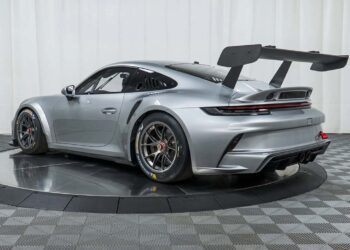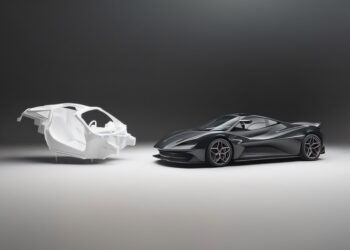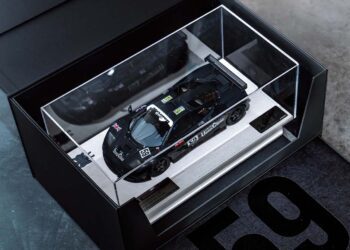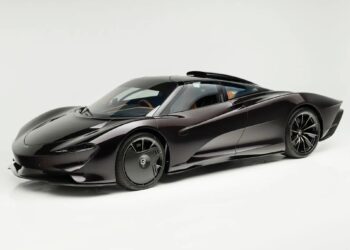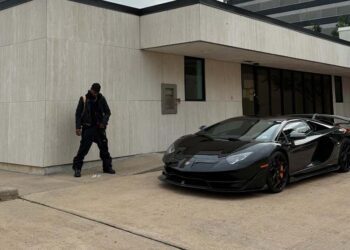“They must’ve thought I was crazy. Very rich, but crazy,” I thought as I blasted past a couple of hikers on my way up the canyons north of Los Angeles. After all, what else could you say about someone who drops seven figures on a lime-green hypercar with no windows or roof?
Over the last decade, hypercars have become increasingly common, with manufacturers pumping out dozens of “limited” and “special” models each year. It used to be that a batch of cars at this level would pop up every decade or so and truly change the game. Think of the Bugatti Veyron in 2005 or the electrified Ferrari LaFerrari, Porsche 918 Spyder, and McLaren P1 in 2013.
With more homogenous seven-figure cars to pick from than ever, what is a thrill-seeking billionaire to do? In 2019, McLaren answered that call with the $1.7 million Elva. An 804-horsepower hypercar with no windshield, windows, or roof. If tons of power alone won’t impress, they must’ve figured a bit of danger would do it. And while limited production numbers typically keep these road-going trophies tucked away in climate-controlled garages, McLaren tossed me the keys to an early Elva prototype so I could taste a bit of this motoring lunacy for myself.

Quick Specs
| Engine | Twin-Turbocharged 4.0-Liter V8 |
| Output | 804 Horsepower / 590 Pound-Feet |
| 0-62 MPH | 2.8 Seconds |
| Weight | 2,809 Pounds |
| Base Price | $1,690,000 |
I woke earlier than usual. It’s a Tuesday in late April, and the thought of driving a prototype of a $1.7 million hypercar, of which just 149 exist, meant there would be no sleeping in. After a shower and a light breakfast, I got into the Audi RS Q8 I was testing that week and set off from the Pasadena suburbs to McLaren of Beverly Hills. As my ETA shrunk, my anxiety crept in. There’s just no telling how a car like the Elva will drive. Will it be quick but manageable, like the 720S? or rabid and relentless, like the 765LT? Could this 591-hp Audi SUV even compare?
The Ferrari 296 GTB came to mind. I had just driven one the day before, and with 818 horsepower on tap, it produces 14 more than the Elva. The big differentiator, of course, is weight. The electrified Ferrari is nearly 1,000 pounds heavier, and despite lugging around that extra heft, it was still overwhelmingly quick.



At 2,809 lb, the Elva is light, especially by modern standards. It weighs nearly as much as a Mini Cooper but develops six times the power. A stat made more believable once you learn that every body panel plus its seats, doors, dashboard, and center console are made out of carbon fiber. Oh, and of course, the Elva has no windows or a roof.
But it does have a windshield. At least this one does. Of the total production run, only a handful have a fixed piece of glass. It was necessary to make the hypercar road legal in the U.S., but even then, fewer than five cars of the dozens living in the States opted for it. Most are genuinely open tops equipped with McLaren’s Air Active Management System, which channels incoming air above the cockpit, creating a bubble of clean air, or as McLaren calls it, an “oasis of calm.”
With production, value, weight, and power figures still rattling around in my head, McLaren of Beverly Hills came into view and sat dead center in its back lot was the lime green Elva prototype, also known as XP12W, waiting for me.

Its presence is all-consuming. None of the surrounding McLaren, Bentley, or Rolls-Royce inventory could peel my eyes off the Elva. Its footprint is larger than you’d expect. At 182 inches long, 77 in wide, and 43 in tall, it’s 3 inches longer, 1 inch wider, but four inches lower than a McLaren 720S. XP12W’s lack of an AASM system on its front clamshell grants this roadster cleaner styling. It’s still a low-slung hypercar inspired by a 60s open-top racecar, but the addition of front glass balances its design and results in a more elegant aesthetic.
Coincidentally, an Artura sat directly next to XP12W in the crowded lot. Their resemblance is uncanny. The Artura debuted in early 2021, but one look at the Elva, which landed in 2019, reveals that one inspired the other. The pair share nearly identical rear ends with horizontal LED tail lights, a wide grille, and twin central exhaust pipes. Up front is a similar story with small angular headlights and large lower air intakes.
My research told me that XP12W wore a two-tone matte blue exterior with contrasting white graphics, but here it sat in lime green. My contact at the dealer explained that it was recently wrapped in the bright shade but offered no explanation while handing me the keys.
Eager to hit the road, I toss my camera bag in the passenger footwell and swing its driver’s side door upwards with surprising ease. They’re not only made of carbon fiber but are entirely hollow thanks to the lack of a window and subsequent mechanism. I was warned to close them cautiously as even a slight tug could result in an unwanted slam, potentially cracking the lightweight material. With that fact skyrocketing my already high anxiety, I pressed the Elva’s central start button, fired it up, and carefully crept away.



Do I head west towards Malibu for a calm open breeze beach cruise or endure an arduous highway sprint to well-known territory up in the Angeles National Forest? Since the chances I’ll get another Elva to play with are slim, I head toward the canyons for a proper blast up a twisty road. I move south from Beverly Hills in morning rush hour traffic towards the Santa Monica Freeway, making little progress between the lights.
Sitting in traffic in any “normal” supercar around Los Angeles is a breeze. Most Angelenos are used to seeing six-figure machines wafting around town, but the Elva is different. You don’t sit in it as much as you do on it. At five foot ten inches, I may not exactly be Lebron James, but still, I feel the upper half of my torso sticking out. XP12W has a windshield, but it’s low, providing a narrow field of view.
I refuse to look over, but I can feel the stares of other motorists. If the bright exterior and eccentric shape won’t grab their attention, the Elva’s exhaust sound will. It may be powered by the marque’s well-known 4.0-liter twin-turbocharged V8, but it sings a unique tune in the Elva. It’s louder and with more bass in its tone. McLarens can sometimes sound video-game-like, but the Elva’s boomy note sounds refined and exotic.

Ignoring the action surrounding the car and my personal embarrassment, the Elva is no more challenging to drive in traffic than a 720S. They’re nearly identical at slow speeds, with its seven-speed dual-clutch automatic effortlessly moving through gears. Even its suspension does a great job of absorbing road imperfections. It’s borderline docile if you ignore that you’re sticking out of a seven-figure hypercar.
I jump on I10, heading west with the Elva’s nose aimed at the canyons. 50 mph? No problem. 60? Just right, 70? It’s getting windy now, 80? I might die today. Highway speeds in the Elva are chaotic. The windshield protects you from the wind as well as a knitted sweater stops a speeding bullet, especially when half of your head sticks out past it. My Apple watch pinged me constantly throughout my one-hour highway stint to tell me I’d suffer hearing loss shortly. All while other drivers swerved around me, trying to look, film, or take photos.
I was miserable, but with the mountains in view, I couldn’t care less. I was almost at the base. My anxiety subsided, making me eager to see what the Elva could do when unleashed. Once I reached the bottom, I tugged its left paddle to drop down a few gears, set the engine to its most aggressive mode, and began the charge up the canyon.

The right pedal meets the floor for the first time, and I’m met with a familiar acceleration experience. The Elva falls somewhere between a 720S and a 765 LT in terms of straight-line aggression. It may have more power than both but lacks the LT’s shortened gear ratios and lags low in the rev range before exploding with performance once you approach the readline. While it’ll hit 60 mph in 2.8 seconds and 124 mph in less than seven, it doesn’t feel overwhelming like it does in an LT.
However, once you factor in the lack of a roof or windows and the tiny windshield, it is the most drama-filled car I’ve ever driven. It’s not speed dependent either. You’re so exposed to the elements that even a stroll feels like a high-speed blast. With so much air flowing through the cabin and the crackling exhaust screaming behind your ears, it’s sensory overload.
Thanks to its lightness, the Elva changes direction like nothing else. Sure, weight is often masked with tires and suspension, but nothing replaces the feel of a lightweight monster diving into a corner with near-instant direction changes.


Like all McLarens, the Elva benefits from an electro-hydraulic power steering system and mechanical brakes, adding to the immersion behind the wheel. The car will move almost intuitively and beautifully communicates the road surface precisely. The Elva is capable like you’d expect a hypercar to be, but how it engages with you is why you’d pay seven figures for one.
I press on, carefully picking up the pace. I know built-in roll-over bars will deploy if I flip, but the stakes feel higher with so much of me sticking out of the cabin. The Elva isn’t my first time in a hypercar. Last year I drove the Pininfarina Battista and the Bugatti Chiron Super Sport on mountain roads, but the Elva couldn’t be more different. An added sense of danger pushes an Elva drive away from just another blast in a fast car to a truly memorable experience.
I make my way back down and no longer focus on driving as quickly as possible. I’ve broken out into all-out laughter, at which point I blast past a couple of hikers in a scene worthy of Ferris Bueller’s Day Off. I can’t believe a car like the Elva exists. A vehicle this intense, this fast, and this outright insane shouldn’t be legal. But I’m so grateful that it is.
One arduous highway blast back to the dealer with a bit of afternoon traffic, and I’m back at McLaren of Beverly Hills, completely sunburnt and exhausted. During the five hours I spent with the Elva, I covered nearly 150 miles, consumed a full tank of gas, and had a total mental reset on what a modern hypercar should be.
The Elva is so focused on its primary purpose that its most significant weaknesses are its main strengths. Driving through a crowded city or an open highway is miserable, but get it onto a twisty road or track, and it shifts. It becomes what most modern hypercars aren’t. It’s not just quick and capable but exciting and involving as well.
Sure, people will look at you like you’re crazy if you drop seven figures on one, and there’s no possibility of looking cool while piloting a bright open-top hypercar, but the hassle is worth it to drive one of the most exciting cars ever made.




































